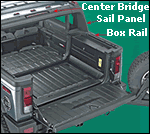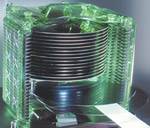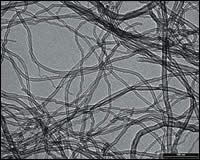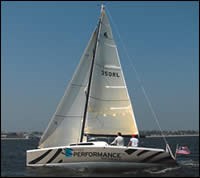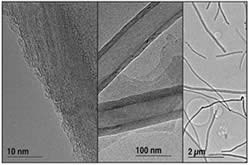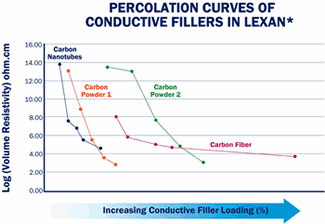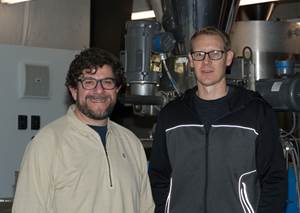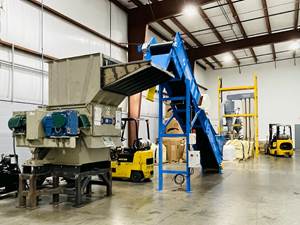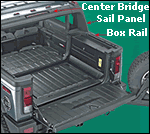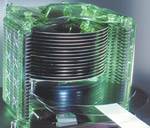Carbon Nanotubes Lots of Potential--If the Price is Right
With capacity scale-ups driving prices down, the pace has picked up for commerical applications that boost electrical and thermal conductivity, structural strength, and thermal stability.
Commercialization of carbon nanotubes and other electrically conductive nano-particles have been hampered by high cost and minuscule supply, but both limitations are well on their way to being resolved. These wisps of carbon appear to be headed toward a much broader scope of commercial use than the less expensive nanoclays, which opened up the nascent field of nanocomposites.
Where nanoclays are getting play primarily in structural reinforcement and barrier applications, carbon nano-particles can offer electrical and thermal conductivity, structural strength and stiffness, and thermal stability.
Most of the commercial activity involves the use of hollow multi-wall carbon nanotubes (MWCNTs), which are a single tube with five to 15 layers; and the closely related carbon nanofibers (CNFs). Less advanced commercially are single-wall carbon nanotubes (SWCNTs), which are hollow tubes with one layer.
Although high cost is a hurdle to commercialization of all these carbon nano-particles, SWCNTs have a much higher barrier to leap, as their prices are 50 to 100 times above MWCNTs or CNFs. But prices of all types of carbon nano-particles are gradually declining, as capacities are being scaled up by old and new players alike. Commercialization is also being advanced by a handful of savvy compounders.
Rolls of graphite
Vapor-grown hollow carbon nanotubes are cylinders made from rolled-up planes of hexagonally-bound carbon atoms. Resembling steel-wool pads under a microscope, nanotubes form entanglements of curved, intertwined strands, rather than long, straight fibers.
Nanotubes are typically 1000 times smaller in diameter than conventional carbon fibers. SWCNTs have a typical outside diameter of 1 to 2 nanometers (nm) while MWCNTs have an OD of 8 to 12 nm. They can range in length from a typical 10 microns to as long as 100 microns and have at least a 1000:1 aspect ratio.
Carbon nanotubes have 10 to 50 times the tensile strength of stainless steel (20 to 100 GPa vs. 2 GPa) and five times the thermal conductivity of copper, with the SWCNTs at the high end. When incorporated into a polymer matrix, they can boost electrical and thermal conductivity by orders of magnitude over the performance possible with traditional fillers such as carbon black or metal powders.
Says Ned Bryant, senior product development engineer at RTP Co., a front-runner in the development of commercial nanotube plastic compounds, “When you measure a single tube, you find they have amazing physical properties. But translating these properties into plastic composites has proven to be difficult.” He says he has not seen reinforcing effects that beat standard carbon or glass fibers from SWCNTs—not for the cost involved. “Dispersion issues are a significant factor that needs to be worked out. There is a strong need for straight, defect-free, high-purity tubes that disperse easily during processing.”
Bryant says the more expensive SWCNTs offer that potential, as they are straight in structure and generally have fewer defects than MWCNTs. “My understanding is that they have excellent properties that would allow you to produce a composite with a very high modulus—as much as 10 times higher than a conventional carbon fiber composite.”
Like carbon nanotubes, CNFs have a hollow core and walls composed of graphene planes. In contrast to nanotubes, where the graphene planes form concentric cylinders around the long axis, CNFs exhibit graphene planes that are canted about 25° with respect to the axis of the filament in what appears to be nested conic sections or a wrapped scroll structure. The hollow core has a diameter about half the total filament diameter.
Surrounding it is the “herringbone” structure of nested graphene layers. CNFs can be produced with the graphene layers at the surface, or with an additional coating of disordered carbon. These coated structures can provide advantages in surface resistivity and functionalization.
Who’s who in nanotubes
The field of entrants into carbon nanotubes has expanded rapidly since the expiration of patents held by the 25-year-old pioneer of carbon nanotubes, Hyperion Catalysis International. In the last three years, Hyperion has reportedly scaled-up to full-scale manufacturing capacity of its “Fibril” MWCNTs, although the firm will not disclose its capacity. Hyperion is the only carbon nanotube supplier that sells its product in resin masterbatches.
Last year Bayer MaterialScience unveiled a new process for making electrically conductive MWCNTs on an industrial scale with consistent purity and considerably lower cost. Bayer sees potential for its Baytubes in electrostatically paintable automotive parts, antistatic films for packaging electronic components, and EMI shielding of computers and cell-phone housings.
Baytubes are said to comprise up to 15 graphene layers (more than most other MWCNTs, which typically have six to seven layers). Bayer has scaled up its production pilot plant from 30 to 60 tons/yr. The next step reportedly will be to boost capacity to 200 tons/yr in the next two years, with an industrial-scale 3000-ton (6.6-million lb) plant envisioned for 2011-12.
Another key player is France’s Arkema, with its Graphistrength MWCNTs. Chris Roger, director of corporate and external research in Philadelphia, says the company has been operating a pilot unit since early 2006 in the south of France that is producing 10 mt/yr (22,000 lb/yr) and is now running five days a week, 24 hr a day. “This is our first scale-up, with the next one scheduled for 2010/2011 and planned to produce a few hundred tons per year.”
Another new entrant is Belgium’s Nanocyl, which had been operating a 5-ton/yr pilot plant, but is due to start up 35-ton/yr commercial capacity next month. North American marketing manager Andy Rich says a significant part of the capacity from the new plant has been pre-sold. As a result, another scale-up is being planned.
Pyrograf Products has been working on both larger capacity and quality control over the last five years, according to Max Lake, president. “We now have 25 mt/yr and by 2009 we expect to be sold out,” he says. Pyrograf aims to expand to 100 mt/yr by 2009 and potentially by as much as 1 million lb/yr by 2012.
Three other players appear to be scaling up. One is San-Diego-based Ahwahnee Inc., which has reportedly developed a process to allow for the highest volume production of economical MWCNTs, and is seeking partners to develop applications such as reinforced and conductive composites.
Two South Korean companies are also said to be actively seeking partners in the U.S. One is Carbon Nano-Material Technology, which produces CNFs, and claims to have a mass-production technology at a cost only 20% to 30% as high as existing technology.
The other is Iljin Nanotech, which can currently supply both SWCNTs and MWCNTs and claims to offer them at a low price.
Pyrograf’s Lake says Japan’s Showa Denka has plans to increase nanotube capacity from 40 mt/yr to 100 mt/yr by 2008, and to introduce new grades for sale in North America, including one similar to Pyrograf’s CNF, as well as a MWCNT.
Two suppliers of SWCNTs in North America are also scaling up. Raymor Industries Inc. in Canada launched its first high-capacity plant for up to 3.5 tons/yr in early 2006. The company’s Raymor Nanotech Div. has been producing SWCNTs at 10 kg (22 lb) per day.
Houston-based Carbon Nanotechnologies, Inc. (CNI) recently merged with Unidym of Palo Alto, Calif., and is now known as Unidym, Inc. CNI has made SWCNTs commercially for two years. Says David Karohl, director of business development, “We have scaled-up capacity, plus we are tailoring SWCNT grades for specific applications like processing in polymer blends. Our CNI Buckytubes, ESD conductive polymer grades are designed to impart electrostatic-discharge conductivity to polymer compounds using traditional melt processing equipment.”
New start-up Vorbeck Materials Corp. has licensed a technology developed at Princeton University that enables an economical commercial scale-up of conductive functionalized single-sheets of graphite, or graphene, for use as “multifunctional” fillers. The Vor-x graphene nanofillers boast a combination of mechanical and electrical properties that are reportedly superior to those of carbon nanotubes, with barrier and thermal properties equivalent to nanoclays.
Prices are moderating
Suppliers and compounders concede that various price reductions have occurred over the last few years for these carbon nano-particles. Nanocyl’s Andy Rich says within the last year MWCNT prices have dropped by as much as 40%—below $200/kg down from $275/kg, for multi-ton purchases. Arkema’s Rogers says, with recent scale-ups, prices are lower by a factor of 2 or 3 than 6 years ago.
Lance Criscuolo, v.p. of global sales for Zyvex Performance Materials, which has a strategic alliance with Arkema, says prices of MWCNTs have dropped by more than 50%—$300/kg (or, about $150/lb) versus $700/kg, just 18 months ago, adding that Zyvex’s Nanosolve masterbatch cost is tracking the same reduction in cost.
Hyperion Catalysis’ marketing director Pat Collins says its Fibril MWCNT masterbatches are selling at around $50/lb. Some are higher, depending on resin, difficulty in processing and percent loading, he says.
Pyrograf Products makes vapor-grown Pyrograf II carbon nano-fibers (CNFs) that cost around $100 to $150/lb. Lake believes that MWCNTs and CNFs can be made at the high production capacity of carbon black and low price. “Worldwide capacity is expanding with the consequence that commodity pricing for CNF could be available in two years. We expect to reduce our price by a factor of 2 if we are sold out. I predict that over the next few years, both MWCNTs and CNFs will sell at around $60/lb, and some may already be there.”
According to director of technical marketing Steve Kidd, Compounder Premix Thermoplastics has experience with producing masterbatches and compounds with all three types of nano-particles—CNFs, MWCNTs and SWCNTs, and cites these price lists, respectively, of $100/lb, $250/lb and $500/lb.
Says Arkema’s Roger, “With SWCNTs, you have to go after high-volume applications due to the high costs, with the exception of niche markets such as satellites or defense applications where they don’t use large volumes. “Their cost is going down now —by about 20% to 25%—or from $600/g to $500/g, but they still need to drop by an order of magnitude,” he adds.
Raymor’s Robert says SWCNT pricing will have a similar evolution as its production capacity reaches a quantity of tons. “We will supply high quality SWCNTs at a low cost of $20/g for large-volume consumer applications compared to our competitors’ much higher prices.”
Karohl for Unidym says prices of “Buckytubes” SWCNTs have come down to the “affordable” range. “Most developments of composites are targeting added costs at the commercial level of between $3/lb and $30/lb of the composite, so as production becomes more efficient at large scale, many applications will become viable via SWCNTs,” Karohl says.
How far have they come?
As the elder statesman in this business, Hyperion Catalysis notes that the bulk of the existing commercial business is in electrical conductivity. “Real commercial applications in the U.S. and elsewhere have been in the use of carbon nanotubes for conductive static dissipative (ESD) in various polymers used in direct contact for moving fuel—ranging from fuel lines to fuel pumps,” says Collins.
Commercial uses of MWCNTs include nylon 12, acetal, fluoropolymers, fluoroelastomers, and PPS. Says Collins, “Our Fibrils are widely used primarily in nylon 12 fuel lines by the U.S auto industry, although some still use carbon black.” Another application is O-rings, made of fluoroelastomers with nanotubes as a conductive additive, Collins notes. They are used in nylon 12 quick-connects where nanotubes preserve the electrical pathway to ground.
Current applications also extend to fuel pumps typically made with acetals, as well as filter housings made with acetal or nylon. Typical loading required to achieve electrical conductivity yet allow the polymer to retain key properties (such as low durometer and barrier retention) are under 5% vs. carbon black, which requires 10-15% loadings.
Meanwhile, their use for on-line electrostatically paintable exterior automotive body panels has been a major breakthrough. Says Collins, “Plastic parts must be conductive enough to preserve path-to-ground so that the electrostatically sprayed color is applied evenly to both plastics and adjacent metal panels. For such parts, nanotubes offer the best way to make a conductive plastic while maintaining acceptable properties, particularly toughness, so it won’t shatter in cold temperatures. We can preserve half the elongation at break of a polymer vs. 3% to 4% only preserved when carbon black is used. Also, because the MWCNTs are so small and used at such low loadings, you get a Class A surface finish.”
Two major players using MWCNTs in such applications are GE Plastics, with its Noryl GTX PPO/nylon alloys, and more recently, Lanxess, with its Triax nylon/ABS alloys. Noryl GTX has been used in front fenders of several European cars. Other potential uses being evaluated are outer door shells.
Use of MWCNTs in composite electronics applications, which include polymers such as PEEK, PEI and PC, have been aimed at clean-rooms, such as manufacturing of computer chips and hard drives, where the plastic must be static dissipative and clean. Suppliers concede that the cleanliness issue is the key advantage of carbon nanotubes over chopped milled carbon fibers, and that their smaller size provides much more uniform conductivity.
Hyperion sees the reinforcement of plastics as the “holy grail.” Says Collins, “No one has yet to overcome the interface adhesion needed between the material and the nanotube without making the polymer brittle. We get 20 to 25% higher stiffness, but what about getting to the 100 to 200% stiffness increase of which they are capable?”
Competition broadens scope
Nanocyl’s Rich ventures that ESD applications, the major market driver, are evenly divided between automotive and electronics.
In terms of enhancing mechanical reinforcement, Nanocyl has developed an experimental purified, functionalized double-wall CNT. This two-layer nanotube more closely resembles the MWCNTs in how they are manufactured, yet has properties akin to a SWCNT. As a result, it reportedly holds a lot of promise for mechanical property enhancement.
In early trials with an epoxy composite containing 50-60% carbon fiber, the incorporation of 0.5% of this double-wall CNT in the polymer resulted in increases of 10% to 15% in stiffness and strength, and 25% to 30% improvement in interlaminar shear strength.
In addition, research indicates that MWCNTs not only increase thermal conductivity and ESD while retaining stiffness, but also can boost flame retardancy of a non-halogenated flame retardant polymer just over the edge to meet more stringent requirements. Trials also show MWCNTs can be combined with their cheaper nanoclay cousins to boost flame retardancy and at lower cost.
Arkema’s Roger sees the electrical conductivity area as key. “You can achieve it by using less than 1% compared to 20% carbon black without losing mechanical properties.”
Commercial applications are primarily through the company’s license agreement with Zyvex Corp. Arkema also has a license to Zyvex’ Kentera technology and is a distributor in Europe for Zyvex’s Nanosolve products.
Through its strategic alliance, Zyvex manufactures its Nanosolve concentrates and compounds using Arkema’s MWCNTs. They are produced using its proprietary Kentera polymer and process, which is designed to integrate the nanotubes into the plastics. Says v.p. of global sales Lance Criscuolo, “It debundles the nanotubes and disperses them uniformly, which makes them compatible with the polymer and improves adhesion.”
Most of Zyvex’s commercial work has focused on thermosets such as epoxy and polyurethanes. The composite shaft of a new nanoline of golf clubs from Aldila Inc., Poway, Calif., is one key success story. The shaft is an epoxy-based pre-preg with uni-directional carbon fibers, whereby .5 to 1.5% of Nanosolve by wt. of resin is added to the epoxy.
Another success has been the use of glass- or carbon-fiber epoxies in the mast of a racing yacht from Synergy Yachts, where small Nanosolve levels in the epoxy significantly increase the mast’s stiffness and flexural properties.
Other commercial areas where structural enhancement has been rendered by Nanosolve masterbatches include bats manufactured by Easton Sports, whereby the nano-enhanced resin is used throughout the bat, including the barrel. Also by Easton Sports are hockey sticks that use the nano-enhanced resin in the shaft and the blade.
Another focus for structural enhancement are aerospace applications using carbon- or glass-fiber epoxy composites. “The incorporation of Nanosolve results in significant improvements in compression, flexural strength and modulus,” says Criscuolo.
He elaborates, “We are working in developing a wide range of thermoplastic applications. For example, with PP, we are aiming for structural reinforcement for defense ballistic applications, such as body armor, while with PC we are looking at EMI shielding for consumer electronic components.”
Pyrograf reports that a good data base for CNF has been developed, showing significant improvements in tensile strength, tensile modulus and interlaminar shear properties in composites. Commercial applications have encompassed two schools of thoughts, company president Lake says, such as with GM and other users of low-cost commodity polymers such as PP, whereby a large body of work has been compiled. The other school of thought reflects the current cost of CNF and CNT, and within this group, effort is directed to more expensive polymers such as PEEK.
Pyrograf has worked with companies producing conductive thermoplastic composite components to replace carbon steel in electrostatic precipitators for the coal powered plants. Also, work has been done on ESD painting of composite body panels where CNFs can improve electrical conductivity and strength, but no applications are imminent. They are also working with CNF-enhanced PEEK composites for under hood automotive and aerospace applications.
Compounder NanoSperse LLC makes dispersions of Pyrograf’s CNFs for thermoset compounds, but Lake envisions that thermoplastics will play a big part in nanotube developments.
Slower developments with the focus on structural enhancement are already underway. Lake notes that this would be huge, and there is already a “force of pioneers” who are buying 20-50 lbs of MWCNTs and CNFs to develop PP and TPO composite products.
Most of Pyrograf’s commercial applications are primarily in Europe where the CNFs are used for electrical conductivity in fuel lines, an area pioneered by Hyperion.
Progress of SWNTs
Karohl from Unidym says that while Buckytubes (SWCNTs) can make polymer composites electrically conductive without the loss of physical properties such as toughness, they can also enable the formulation of entirely new products, such as flexible, clear, and conductive films for use in electronics (e.g. touch screens and displays). Unidym is now gearing up to sell transparent conductive films (e.g., roll-to-roll coatings), he says.
The company is aiming its SWCNTs at mid-range to high-end engineering thermoplastics, from PC and nylon to PEEK and PEI, where multiple improvements are needed, including thermal conductivity, higher heat distortion temperature, improved tensile, flexural and impact strength. Moreover, they now have specific grades reportedly much better suited to melt processing. Target markets include electronics, such as hard drives, coatings, sealed bearings and gaskets for semiconductors and automotive, and aerospace fuel systems. Thermosets such as vinyl ester composites can also benefit from SWCNTs, requiring loadings as low as 0.015% to achieve as much as a 37% increase in shear strength.
Raymor Nanotech’s Robert says that since the second quarter of this year the company has offered various high-purity grades of SWCNTs to rapidly penetrate emerging applications, ranging from polymer nanocomposite enhancement to biomedical and nanoelectronic devices.
The primary market for its mass-produced SWCNTs is the aerospace and aeronautical sector.
Compounders ahead of the game
A handful of compounders have been in the forefront of nanotube compound development. RTP Co., which introduced a line of nanotube compounds six years ago, recently launched its new line of CNT compounds (all based on MWCNTs), that are available in PC, PBT, glycol-modified PETG, PPS, PEI and PEEK.
According to Bryant, proprietary nanotube processing techniques have resulted in compounds that offer substantial performance improvements. “We can get the same electrical conductivity properties at lower loading, and will soon introduce nano-enhanced fluoropolymers, liquid crystal polymers, acetals, and various nylon compounds. The typical range of surface resistivity for our CNT compounds, is 103 to 1010 ohm/sq.”
Primary commercial applications are in electronics, primarily hard disk drives, silicone wafer manufacturing and associated manufacturing lines.
A recent example is the use of a newly reformulated, customized RTP 300 Series conductive CNT PC compound which met the requirements for ESD protection, dimensional stability and low particulation set forth by San Diego-based Iomega in designing its new removable REV disk that can store 35 GB of data and up to 90 GB of compressed data and is designed for data backup on the REV Backup Drive.
GE Plastics’ LNP Engineering Materials has been producing conductive compounds under its Stat-Kon line, which include grades that are enhanced with carbon nanotubes for applications such as semiconductor markets due to the electrical conductivity and purity they offer. Areas they continue to explore include applications in automotive and electrical/electronic and semiconductor fabrication, where their electrical conductivity properties and cleanliness bring value, according to product manager Jim Fagan.
LNP was possibly first to offer static-dissipative thermoplastic compounds, initially PEEK and PEI, which utilized MWCNTs. More recently, LNP also has been selling nanotube-enhanced Lexan PC, and continues to market nanotube-enhanced Noryl GTX PPO/nylon for use in ESD painting of exterior auto body panels.
PolyOne Corp.’s R&D manager David Jarus says they have field evaluations for plastics, primarily in the electrical/electronics area, which he feels has the most bang for the buck right now. “Nanotubes are making it in electrical conductivity applications, but purity is truly the key as carbon fibers can render similar performance. Overall, you need to get multiple improvements to justify the cost of nanotubes. Besides electrical conductivity, nanotubes can provide amazing stability as an antioxidant to prevent radicals when plastics break down. We see them as an enabling technology for very customized applications, so we don’t have a standard line of nanotube masterbatches.”
Premix Thermoplastics has had experience with all three types—MWCNTs, CNFs and SWCNTs in producing masterbatches, says director of technical marketing Steve Kidd.
For example, it offers masterbatches of PEEK with 30% loading of Pyrograf’s CNFs, as well as masterbatches of PEI and other high-end engineering thermoplastics with loadings of 20% of Hyperion’s MWCNT concentrates and other raw nanotubes.
“These nanoadditives perform differently due to their different structures,” says Kidd. “For example, CNFs at 70 nm-100 nm can only handle lower shear in order to keep the fibers length without destroying the fiber, while MWCNTs need a lot of shear to break them down and disperse them.”
Related Content
Processing Megatrends Drive New Product Developments at NPE2024
It’s all about sustainability and the circular economy, and it will be on display in Orlando across all the major processes. But there will be plenty to see in automation, AI and machine learning as well.
Read MoreMore Than a Compounder: They Have the Science to Create New Custom Materials
Insight Polymers & Compounders leverages its expertise in polymer chemistry to develop next-generation materials.
Read MoreSmall Batches, Big Success
With no minimum order and an impeccable record of on-time delivery, Precision Color Compounds is becoming a force in the color masterbatch business.
Read MoreEngineering Resins Compounder Expands to Take on More Scrap
Polymer Resources responds to sustainability push by upgrading plant with grinding and shredding equipment to take on both postindustrial and postconsumer reclaim.
Read MoreRead Next
Nanocomposites Broaden Roles in Automotive, Barrier Packaging
Nanocomposites are gradually gaining acceptance in the mainstream of global plastics processing. These polymer compounds, containing relatively low loadings (under 6% by weight) of nanometer-sized mineral particles, are beginning to show up in polypropylene and TPO-based automotive exterior claddings, barrier beer bottles, nylon packaging films, polyethylene pipe and wire/cable coatings, and more.
Read MoreChasing Nanocomposites
Nano-sized particles have mega-potential in plastics because just a pinch does so much more than heavy loadings of other additives. Three recent conferences presented almost 200 papers on the feverish pace of ‘nano’ R&D on boosting plastics’ mechanical and barrier properties, flame retardancy, and electrical conductivity.
Read More"Electrically Active" Compounds Surge In Performance
Designing a thermoplastic compound to conduct an electrical charge is difficult and costly, since most polymers are naturally ill suited to the task.
Read More


